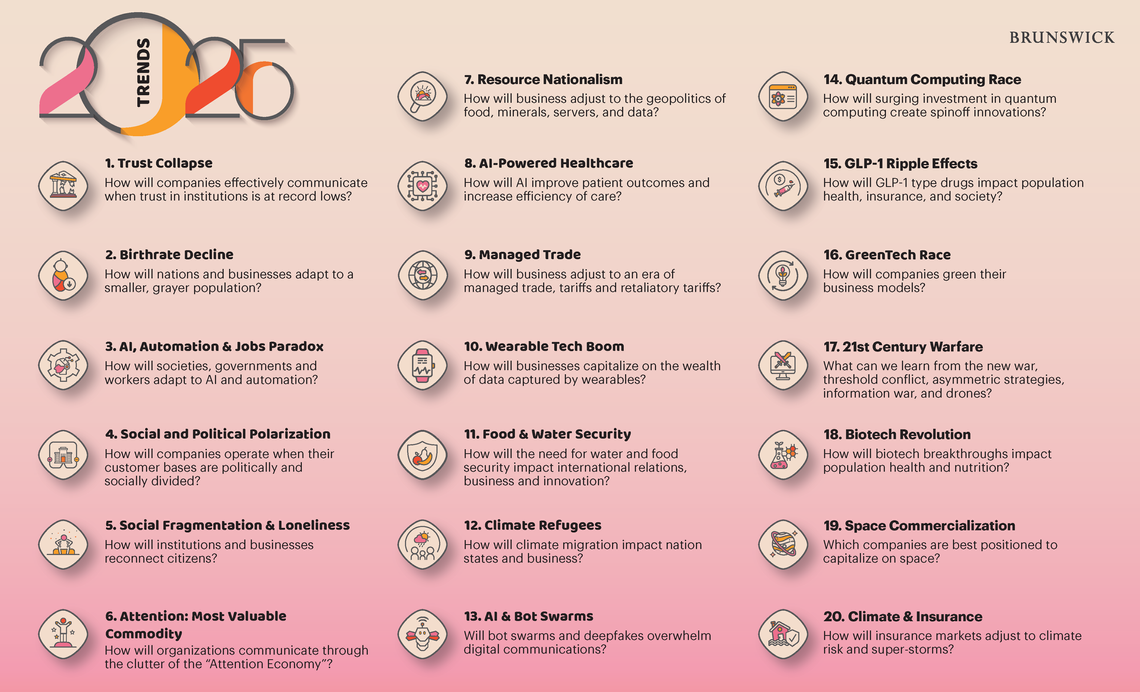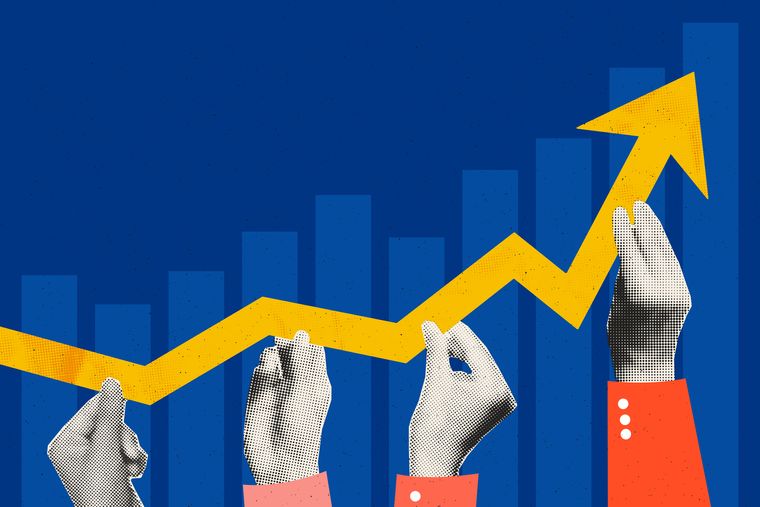2025 Trends
Market and opinion research provides a snapshot of current conditions. In today's VUCA world—volatile, uncertain, complex, and ambiguous—decision-makers need data that informs both the present and the future.

Market and opinion research is a snapshot in time. But we live in an accelerating and turbulent era. It’s a VUCA world – Volatile, Uncertain, Complex, and Ambiguous. Decision makers need hard data on the present, data that will bring the outside in and help them understand their operating environment. But these snapshots only take us so far. They answer the “what” and the “so what”, but not the “what next.” For that we need strategic foresight. To extend the analogy, we can increase the rate at which we take research snapshots, but in an accelerating and turbulent world we eventually need to leverage foresight tools in order to anticipate what comes next.
Every year Brunswick conducts a horizon scan based on a STEEP analysis of the Social,Technological, Economic, Ecological, and Political drivers of change. This horizon scan generates twenty trends that leaders should consider as they plan for the years ahead. While many of these are well beyond traditional consumer trends that marketers and market researchers focus on, they will impact the business environment and could influence consumer behavior as their impact flows downstream.
Our STEEP analysis identified the following twenty trends for 2025:
1. Trust Collapse
2. Birthrate Decline
3. AI, Automation and Jobs Paradox
4. Social and Political Polarization
5. Social Fragmentation and Loneliness
6. Attention: Most Valuable Commodity
7. Resource Nationalism
8. AI-Powered Healthcare
9. Managed Trade
10. Wearable Tech Boom
11. Food and Water Security
12. Climate Refugees
13. AI and Bot Swarms
14. Quantum Computing Race
15. GLP-1 Ripple Effects
16. GreenTech Race
17. 21st Century Warfare
18. Biotech Revolution
19. Space Commercialization
20. Climate and Insurance

While all of these twenty trends are important and will collectively touch almost every business, we’ll focus on the trends most likely to impact the B2C businesses that most Research World readers support in their professional work.
It is worth noting at the outset that four of the top five trends are overwhelmingly social in nature. 2025 will be a big year for a range of technologies, like AI, wearables, GreenTech, BioTech, GLP-1, and aerospace and defence, but the big change drivers in 2025 are likely to be social in nature. These include a collapse in social trust between people and institutions, a steep birthrate decline, social and political polarization, and loneliness. Based on the work of ResearchWorld readers, we will preview these four social drivers plus managed trade, the wearable tech boom, and food and water security.
#1 Trust Collapse
Vertical trust, trust between people and institutions, has been in freefall for years and has now hit rock bottom. In the United States trust in the federal government “to do what is right just about always or most of the time” has declined from the 73%-77% range in the Eisenhower, Kennedy, Johnson era to only 22% in 2024, according to Pew Research Center. This phenomenon is not limited to the United States. An OECD survey in late 2023 found that 44% of citizens across 30 countries have no or low trust in their governments and only 39% have high or moderately high trust. Collapsing trust in institutions is obviously problematic, but we are also witnessing collapsing trust in fellow citizens, a basic attitude that predicts a functioning economy and healthy society. While most Scandinavian and Chinese citizens report social trust levels over 50% (example: Norway at 72% and Denmark at 74%), most countries exhibit shockingly low trust in their fellow citizens, according to the World Values Survey. Australia (49% “most people can be trusted”), Canada (47%), The United Kingdom (43%), and Germany (42%) exhibit similar social trust levels, but even with a 40% minority trusting their neighbours, they are well ahead of the rest. For example, only 37% of Americans believe that “most people can be trusted” and this falls to only 17% of Indians, 10% of Mexicans and an even lower 7% of Brazilians. Declining vertical and horizontal trust is a symptom, not a cause, and it is an urgent problem of our time. Declining trust increases economic friction and challenges businesses and brands. What can businesses do to increase institutional and social trust?
#2 Birthrate Decline
Leaders have been concerned with over-population ever since Paul R. Ehrlich published The Population Bomb in 1968. But, contrary to the book’s thesis, the world now faces the prospect of rapidly shrinking population, an unfavorable worker to retiree ratio, and a declining youth market. The UN reports that the global population will peak in the 2080s at 10.3 Billion. But, over half of all countries now have a fertility rate below the replacement rate of 2.1 births per woman. Total population has already peaked in 63 nations or regions, including China, Russia and Germany. The fertility rate in the U.S. fell to the lowest rate on record last year. From a business and marketing perspective, this suggests we may experience declining economic growth rates, a shrinking youth market, but a booming market for eldercare products.
#4 Social & Political Polarization
Declining levels of institutional and social trust, the decline of mass media as a universal reference point, and disagreement over zero sum game cultural issues has created a hyper-partisan social landscape in the United States and many other nations. As just one example, the Pew Research Center found that partisans are increasingly associating negative attributes to voters supporting the opposing party, including attributes like “dishonest”, “unintelligent”, “immoral”, and “lazy.” As an example this research found that 72% of Republicans view Democrats as more immoral than other Americans, while 62% of Democrats say Republicans are more immoral than other Americans. How will businesses with well-known brands operate in this polarized environment? Brands that generally appeal to consumers in one political party may not be challenged by this polarization, but universal consumer brands attempting to sell products to consumers across the ideological spectrum may encounter pushback on anything that appears overtly partisan.
#5 Social Fragmentation & Loneliness
Loneliness and social isolation haunt modern society. For example, 8% of Americans report having no close friends and 29% report two or fewer close friends, according the Pew Research Center data in 2023. And, according to the State of American Men Survey in 2023 65% of American men between the ages of 18 and 23 agree with the statement that “no one really knows me well.” The extreme case can be found in the Japanese phenomenon of hikikomori, in which younger men retreat to their rooms as shut-ins. Estimates suggest that approximately 2% of the Japanese population have withdrawn. Could businesses and brands fight loneliness and encourage human connection by promoting social rituals connected to their products? How do we reconnect with each other?
#9 Managed Trade
In 2021 a Foreign Policy magazine analysis announced that “Free Trade Is Dead. Risky ‘Managed Trade’ Is Here.” The most recent US elections suggest that America and many other nations are moving away from “free trade” and toward protectionist policies designed to enhance their nation’s economic security. A New York Times survey just before the election found that 55% of voters in battleground states supported “the tariffs on China imposed by President Trump.” And a Reuters/Ipsos survey in early September found that 56% of American voters were more likely to support a candidate who proposes “enacting a 10% tariff, or tax, on all imports as well as a 60% tariff on imports from China.” The large trading nations of the world may step back from the brink of trade war, but the direction of travel is toward “managed trade” and the possibility of retaliatory tariffs. Businesses, marketers, and researchers have no control over global trading regimes, but protectionist trading rules would certainly complicate matters for foreign brands selling in markets that erect trade barriers. On the flip side, this development could significantly advantage local brands.
#10 Wearable Tech Boom
Nearly 50% of American internet households now own and actively use wearable technology.Wearables, including a wide range of watches, rings, glasses, goggles, and earbuds, will empower consumers, give them more information about their environment, and give them (and others) more information about their health. The wearable tech boom will continue the trend of the “quantified self” and could increase the market for a range of wellness products. It could also power consumer privacy concerns. The wearable tech boom could be a demand driver, but it could also lead to additional restrictions on the use of consumer data. Finally, AI-enabled smart glasses have the potential to become the convergent point for AI, wearable tech, and mobile purchasing.
#11 Food and Water Security
According to UNICEF research, almost two thirds of the world population experiences severe water scarcity for at least one month per year. Moreover, over two billion people live in countries where the water supply is inadequate. And UNICEF estimates that up to 700 million people could be displaced due to extreme water scarcity. Critically, only 3% of the world’s water is freshwater, making it the most important of all scarce commodities. In parallel the world faces the risk of food insecurity. The world produces enough food to feed everyone, but as the World Food Program notes, conflict, climate shocks, economic shocks, and poverty create production and distribution friction that resulted in one in eleven people worldwide facing hunger last year.
Businesses have long been pushed to reduce their water usage, especially in the manufacturing process. As water scarcity increases, businesses with greater water efficiency will hold a competitive advantage relative to less efficient peers. Marketers may also increase their consumer appeals on water stewardship and commitment to fight against world hunger.
Opportunity in the Chaos
Trends 2025 forecasts a wide range of turbulent trends. On its face this may seem like bad news, but these are things that are known to us, can be studied, and addressed. We may live in a turbulent, VUCA world, but strategic and resilient businesses can take proactive steps now to mitigate risk and find opportunity in the chaos.


